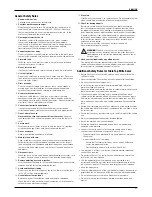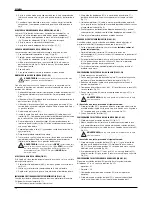
ENGLISH
29
•
Apply only a gentle pressure to the tool and do not exert side
pressure on the saw blade.
•
Avoid overloading.
•
Always remove the dust from the machine after using to
ensure the lower guard operates properly.
The attention of UK users is drawn to the “woodworking machines
regulations 1974” and any subsequent amendments.
PRIOR TO OPERATION
• Install the appropriate saw blade. Do not use excessively worn blades.
The maximum rotation speed of the tool must not exceed that of the
saw blade.
• Do not attempt to cut excessively small pieces.
• Allow the blade to cut freely. Do not force.
• Allow the motor to reach full speed before cutting.
• Make sure all locking knobs and clamp handles are tight.
SWITCHING ON AND OFF (FIG. A1)
• To switch the machine on, press the on/off switch (1).
• To switch the machine off, press the on/off switch again.
Dust Extraction
WARNING:
Whenver possible, connect a dust extraction
device designed in accordance with the relevant regulations
regarding dust emission.
Connect a dust collection device designed in accordance with the relevant
regulations. The air velocity of externally connected systems shall be
20 m/s +/– 2 m/s. Velocity to be measured in the connection tube at the
point of connection, with the tool connected but not running.
Refer to
Optional Accessories
for more information.
Transporting
Transport the machine using the hand indentations.
WARNING:
Always transport the machine in saw bench mode
with the upper blade guard fitted. Never carry the machine by
the guard.
Basic Saw Cuts
SAWING IN MITRE SAW MODE
It is dangerous to operate without guarding. Guards must be in position
when sawing.
Ensure that aluminum workpieces are clamped securely.
VERTICAL STRAIGHT CROSS CUT (FIG. A1, K)
1. Slacken the mitre latch (8) and subsequently squeeze it.
2. Engage the mitre latch (8) at the 0° position and fasten the mitre latch.
3. Place the wood to be cut against the fence (11).
4. Take hold of machine handle and press the head lock-up release lever
(2) to release the head.
5. Pull down the head approximately 10 mm and release the lock-up lever.
6. Switch on the machine and depress the head to allow the blade to cut
through the workpiece and enter the table slot.
7. After completing the cut, switch off the machine and return the head to
its upper rest position.
VERTICAL MITRE CROSS-CUT (FIG. A1, L)
1. Squeeze the mitre latch (8). Move the arm left or right to the required
angle.
2. The mitre latch will automatically locate at 0°, 15°, 22.5°, 45° and 50°
both left and right. If any intermediate angle is required hold the head
firmly and lock by fastening the mitre latch.
3. Always ensure that the mitre latch is locked tightly before cutting.
4. Proceed as for a vertical straight cross-cut.
WARNING:
When mitring the end of a piece of wood with a
small off-cut, position the wood to ensure that the off-cut is to
the side of the blade with the greater angle to the fence:
– left mitre, off-cut to the right
– right mitre, off-cut to the left
BEVEL CROSS-CUT (FIG. H1, M)
Bevel angles can be set from 0° to 48° to the left. Bevels up to 45° can
be cut with the mitre arm set between zero and a maximum of 45° mitre
position right or left.
1. Loosen the bevel clamp handle (12) and set the bevel as desired.
2. Set the override button (54) if required.
3. Hold the head firmly and do not allow it to fall.
4. Tighten the bevel clamp handle (12) firmly.
5. Proceed as for a vertical straight cross-cut.
Sawing in the Bench Mode
RIPPING (FIG. A2, I1, I2, N)
WARNING:
The bench table is not adjustable in horizontal
position when the guard (18) is not mounted.
1. Set the saw head to the vertical position.
2. Loosen locking knob (60) on left side of fence (11) and move fence to
new position as shown (fig. I1).
3. Slide the guard (18) over the rotating table/mitre arm (9) until threads of
head lock down screw align with threaded bushing in head (fig. I2).
4. Depress the head lock up release lever (2) and press down on the head
while tighening the head lock down screw (13).
5. Set the depth of cut by sliding the table (14) up or down. The correct
position is to have the tips of three teeth above the top surface of the
wood.
6. Set the rip fence (17) as required in order to support as much of the
workpiece as possible. At least the rear end of the fence should be level
with the front of the riving knife.
7. Set the rip fence for the width of cut required by using the scale let into
the front of the table.
8. Switch on the machine.
9. Slowly feed the workpiece underneath the front of the upper blade
guard, keeping it firmly pressed against the rip fence.
10. Remember to always use the push stick (58) (fig. N).
11. After completing the cut, switch off the machine.
Quality of Cut
The smoothness of any cut depends on a number of variables, e.g. the
material being cut. When smoothest cuts are desired for moulding and other
precision work, a sharp (60 tooth carbide) blade and a slower, even cutting
rate will produce the desired results.
WARNING:
Ensure that the material does not creep while
cutting; clamp it securely in place. Always let the blade come to
a full stop before raising the arm. If small fibres of wood still split
out at the rear of the workpiece, stick a piece of masking tape
on the wood where the cut will be made. Saw through the tape
and carefully remove tape when finished.
MAINTENANCE
Your D
E
WALT power tool has been designed to operate over a long period
of time with a minimum of maintenance. Continuous satisfactory operation
depends upon proper tool care and regular cleaning.
WARNING: To reduce the risk of injury, turn unit off and
disconnect machine from power source
before installing
and removing accessories, before adjusting or changing set-
ups or when making repairs. An accidental start-up can cause
injury.
Lubrication
This machine requires no additional lubrication. The bearings of the motor
are pre-lubricated and watertight.
• Avoid using oil or grease as this can cause clogging with sawdust and
chips and create problems.
• Clean the parts subject to accumulation of sawdust and chips
periodically with a dry brush.
Summary of Contents for DW711
Page 1: ...www eu DW711 ...
Page 3: ...1 A1 A2 11 12 2 1 5 3 4 7 8 6 10 9 14 17 19 18 58 13 16 15 ...
Page 4: ...2 25 25 20 21 22 23 21 22 20 26 24 27 21 26 29 32 30 31 15 35 34 36 A3 A5 C1 C3 A4 B C2 C4 16 ...
Page 5: ...3 10 47 38 37 41 40 43 39 4 42 44 45 46 40 7 8 9 D E2 E4 F1 E1 E3 E5 F2 41 ...
Page 6: ...4 43 11 48 49 49 12 12 43 48 50 51 53 52 53 54 12 55 51 F3 G1 G3 H1 F4 G2 G4 H2 ...
Page 7: ...5 2 mm 5 mm 15 57 59 58 I1 J1 K M I2 J2 L N 60 11 18 13 2 9 ...
Page 8: ...6 O P A ...
Page 9: ...7 Q1 61 18 14 62 Q2 ...
Page 114: ...112 ...
Page 115: ...113 ...
















































